If you are wondering why bugs and other pests pay your bathroom a visit, it’s because of all the moisture. And when we’re talking about the toilet seat, in particular, many people fail to clean it consistently and in detail. Flushing isn’t enough, since there is the residue left behind and that is enough to attract all the wrong guests.
Bright Side wants you to know that many pests can crawl into your house through your toilet and that there are ways to prevent this from happening.
1. Snakes
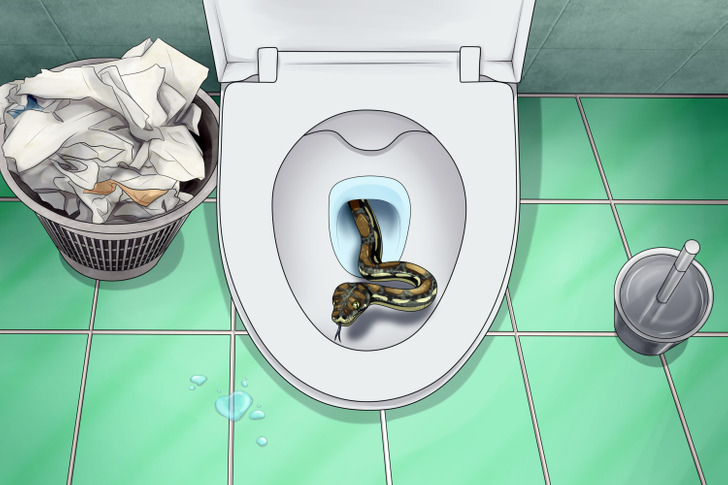
Snakes just love cool, wet, and dark places and that’s why your toilet pipes can be very intriguing to them. But, what drives them there in the first place is the sewer that has food remnants that they can feed on. When they are finished with their food in the sewer, they will look for a way out and the pipes are the easiest and quickest route. However, you shouldn’t be afraid if you live in a cold environment, since snakes will only sneak up in toilets in warm countries.
It’s usually harmless snakes that crawl through the pipes, like garden or tree snakes. That’s because these snakes are slimmer than venomous ones and can fit through the pipes. Although, some anacondas have appeared in people’s toilets in South America and Australia.
2. Rats
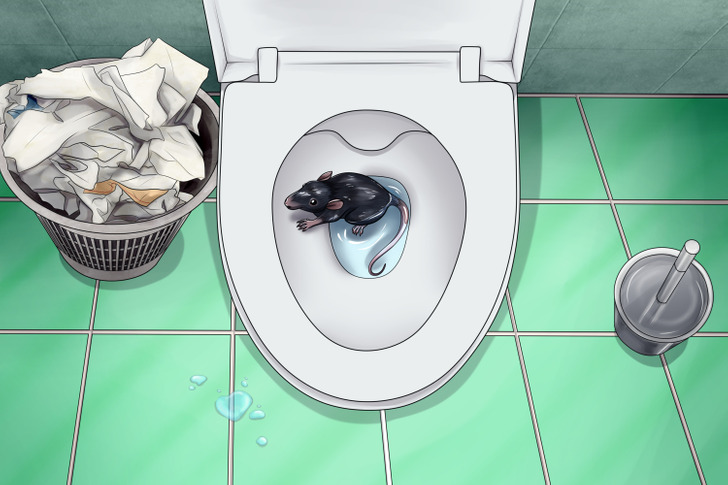
Like snakes, rats are also in constant pursuit of food and our pipes can be very appealing to them. In houses where the toilet and garbage disposal end up in the same pipes, rats are more likely to find a way in. And because their anatomy is very bendy, they can swim through the pipes and hold their breath for minutes before they need air.
So, it’s not just important to discard your food remnants in a trash bag but to also never flush food down the toilet. If there is no food in the pipes, rats won’t have any reason to try and enter your sewage system. You should also keep the toilet cover closed at all times and maybe install a rat guard. This allows water to exit the pipes whenever you flush, but nothing can come up in the opposite direction.
3. Spiders
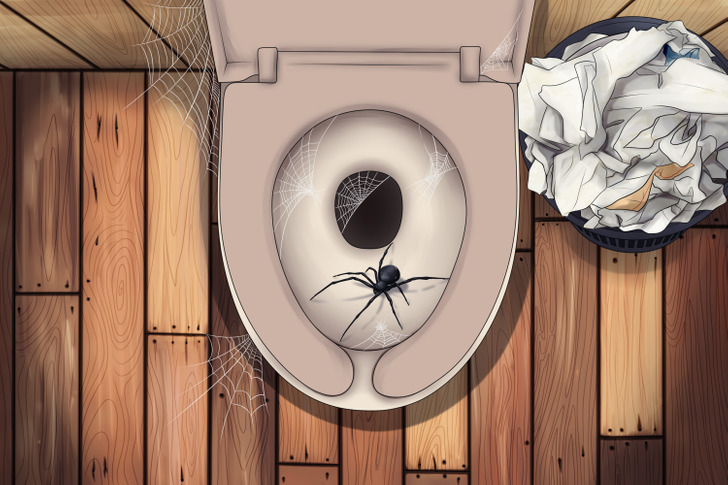
With spiders, things get a bit more complex, since they can’t swim in your pipes, but they can appear in your bathroom through another passage. And when they get in, they will probably sit outside the toilet seat. Only black widows will crawl inside the toilet and weave their web from side to side. But, that will happen only in an outdoor toilet that doesn’t have plumbing and that isn’t connected to a sewer system.
That’s where these venomous spiders thrive since there are many flies that they can catch for food. That’s also why you need to always check the seat thoroughly before using an outhouse toilet. Spiders, like the black widow, the brown recluse, and the hobo spider won’t have any trouble biting you.
4. Lizards
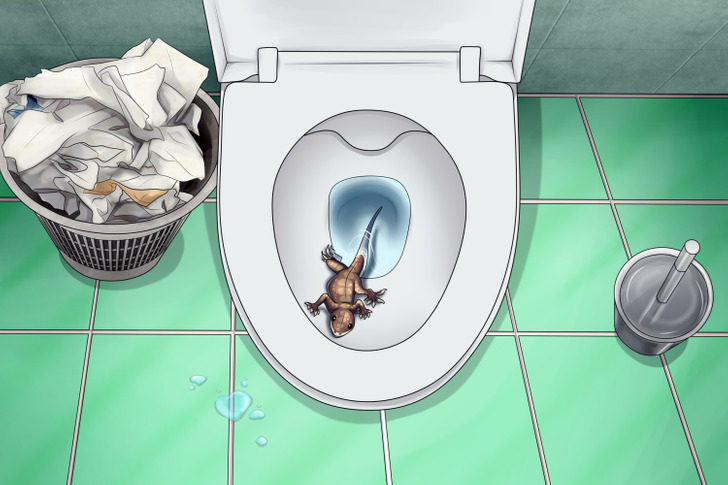
In the Southwest United States, lizards coming through the toilet pipes are a quite common occurrence. That’s because these creatures love water and they try to find food wherever they can. Crickets and other insects (like flies) can be found a lot in your toilet’s plumbing if it’s not kept decently clean. The lizards that can achieve this are usually small enough that they can fit through the pipes.
5. Possums
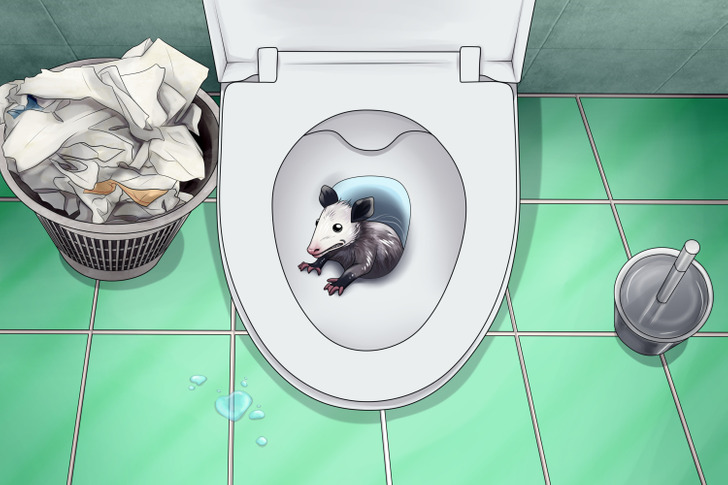
In 2008, a man was in his bathroom in Australia when he saw the water in the toilet gurgling. Moments later, a baby possum appeared and this is not the first time this has happened. On another occasion, a woman found a dead possum in her toilet. These unusual guests are excellent swimmers and can hold their breath for a long time — that’s why they can crawl into your toilet.
How to prevent and react to these occurrences
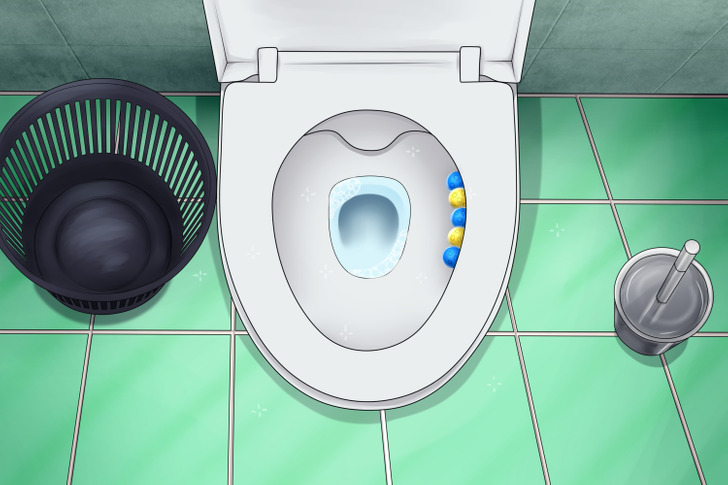
- Keep your toilet clean: This may sound obvious, but you really need to clean your toilet often and neatly. Disinfecting cleaners are perfect for that job and if you want something cheaper you can resort to white wine vinegar or baking soda. You can also get one of those fresheners that stick on the side of the toilet and release a nice smell every time you flush.
- Keep it dry: Most pests love humidity and that’s why they will be attracted to wet bathroom floors. So, it’s important to get rid of any standing water from the sink or the floor after you’ve taken a shower. If you notice any leaks in your plumbing, call a technician immediately and get them fixed.
- Clean your pipes naturally: In a bowl, add equal parts of sugar, water, vinegar, and 5-10 drops of dish soap. Mix all of this together and pour it down the toilet or in your bathroom sink. You can also pour some boiling water into the toilet.
- Call a pest control company: If you don’t have the time or courage to deal with pests yourself, call professionals and let them use their heavy cleaners. After that is done, you can occasionally throw water mixed with a cleaning solution down the drain to make sure no pest will climb up into the toilet.
Have you ever found an uninvited guest in your toilet — if so, what was it and how did you react?
My Son Drew Pictures of a Strange Man — When I Asked Him, He Said, ‘He Comes to See Mommy When You’re at Work’

I was stunned when my son started drawing a grinning stranger. “He comes to see Mommy when you’re at work,” Oliver said innocently. Initially dismissing it as a childish fantasy, I soon spied a mysterious man entering our home, igniting a chilling quest for the truth.
I found the drawing while tidying up the dining table. Most of Oliver’s pictures were what you’d expect from a six-year-old: dinosaurs with rainbow scales, our house with a chimney that looked more like a volcano, and stick figures of our family holding hands. But this one made me pause.

A man frowning at a drawing | Source: Midjourney
Among the crayon scribbles was a tall figure with unnaturally long arms and huge hands, wearing what looked like a suit. The figure had an enormous grin that stretched across most of its face.
“Oliver,” I called out, trying to keep my voice casual as my fingers crinkled the edge of the paper. “Is this me in the picture? Who is this?”
My son looked up from his LEGOs, his blue eyes bright with excitement.

An excited boy with a bright smile | Source: Midjourney
The plastic blocks clattered as he dropped them onto the hardwood floor. “That’s Mr. Smiles, Daddy! He’s Mommy’s new friend. He comes to see her when you’re at work.”
My heart skipped a beat. Laura and I had been married for nine years. We’d had our ups and downs like any couple, weathered job changes and family losses, and celebrated promotions and birthdays. But never, not once, did I think she’d…
No, I shook the thought away. There had to be a reasonable explanation. Laura wasn’t that kind of person. We’d built too much together.

A concerned man holding a paper | Source: Midjourney
“When does he come over?” I asked, proud of how steady my voice remained despite the tremor in my hands.
Oliver stacked another block on his tower, his tongue poking out in concentration.
“Sometimes in the morning. Sometimes at night. He always makes Mommy and me laugh.” He glanced up, suddenly serious, his small face scrunching with the weight of importance. “But, Daddy, it’s a secret! Don’t tell anyone!“

An emotional man standing in a living room | Source: Midjourney
The mention of laughter and secrecy felt like ice in my stomach.
That night, I barely slept, watching Laura’s peaceful face in the darkness. The steady rhythm of her breathing, once comforting, now felt like a taunt. Every time she shifted in her sleep, I wondered what she was dreaming about. Who she was dreaming about.
The next day, I left work early, parked down the street from our house, and waited. The fall air grew crisp as the afternoon wore on, and fallen leaves skittered across my windshield. A little after 3 p.m., a sleek black car pulled into our driveway.

A black car parked in a driveway | Source: Pexels
A tall, wiry man stepped out and marched up to the front door. Even from this distance, I could see his broad smile when Laura welcomed him inside. The door closed behind them.
I gripped my steering wheel until my knuckles turned white; the leather creaking under my fingers.
“Maybe this is all in my head,” I whispered to myself, watching my breath fog the window. “But if I’m wrong, I need to know for sure.”

A man sitting in a car | Source: Pexels
Over the next few weeks, I started buying Laura flowers and gifts, trying to rekindle our bond, but I also began documenting everything.
The evidence piled up: receipts for dinners I didn’t attend, calls she’d leave the room to take, and, of course, more pictures of “Mr. Smiles” drawn by Oliver. Each new piece of evidence felt like another brick in a wall being built between us.
Laura noticed the change in me.

A woman staring at her husband during dinner | Source: Midjourney
“Are you feeling okay?” she asked one day, touching my forehead with concern. “You seem distracted lately.”
The genuine worry in her voice only confused me more. How could she act so normal if she was hiding something so huge?
“I… do you have someone else?” I asked.
“Someone else?” Laura stared at me with wide eyes, then shook her head.

A woman looking at her husband with wide eyes | Source: Midjourney
“Of course not, honey!” She let out a little chuckle. “How could you think that?”
Maybe I should’ve confronted her then, but all my evidence was circumstantial. I needed cold, hard proof.
One Friday evening, I told Laura I’d be working late. Instead, I set up a hidden camera on the bookshelf in the living room and watched the feed from my car parked around the corner.
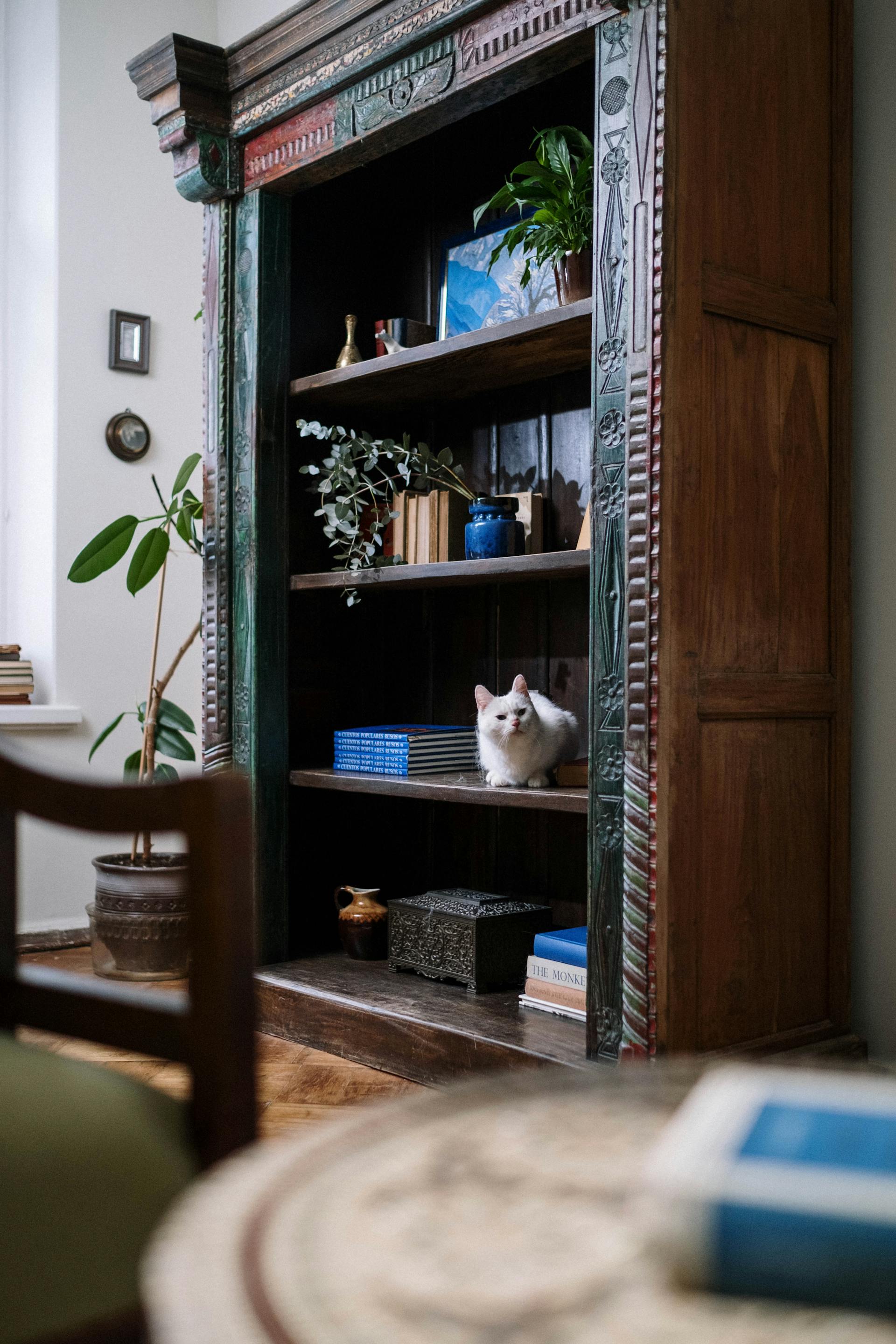
A bookshelf in a living room | Source: Pexels
The screen of my phone cast a blue glow across my face as I waited, my coffee growing cold in its cup holder.
Right on schedule, Mr. Smiles arrived, and Laura greeted him with that same warm smile that used to be reserved for me.
But then something strange happened. He didn’t settle on the couch or share a private dinner. Instead, my sister walked in, and Oliver came bounding down the stairs with a beaming smile. More people arrived: neighbors and friends!

A man looking at his phone in confusion | Source: Midjourney
They all knew about this? And worse, they were having a secret get-together! I watched in stunned silence as Mr. Smiles, now wearing a festive party hat, juggled three oranges for Oliver and made him laugh.
“What the heck is going on?” I muttered, fumbling with my car door.
Rage and confusion propelled me toward the house. The evening air felt thick and heavy as I stormed up our front walk. I burst through the front door, making everyone freeze mid-conversation, the cheerful music cutting off abruptly.
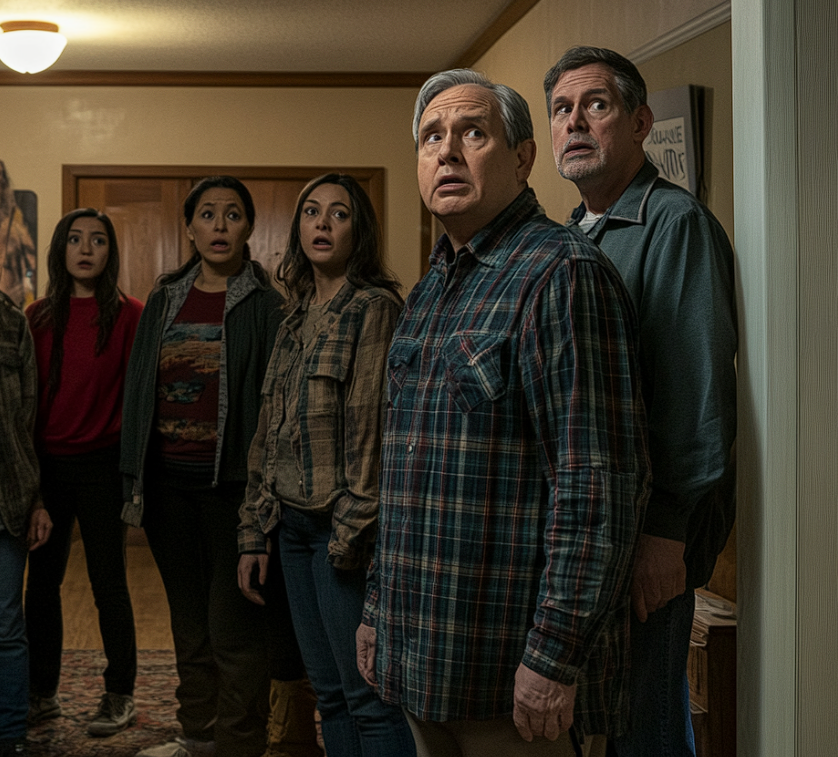
A group of people in a living room staring at someone in surprise | Source: Midjourney
“Alright, you won,” I said, my voice trembling. “Everyone here knew, didn’t they? Even Oliver? Even my sister?”
“No, no! Please, stop!” Laura’s face had gone pale, her hands clutching a roll of streamers that cascaded to the floor.
I turned to Mr. Smiles, who had stopped juggling and was staring at me with wide eyes.
“You’ve disrespected me as a man, and you’ve got no business being here! It’s my house! It’s my…”
My voice trailed off as I spotted something shiny on the floor.
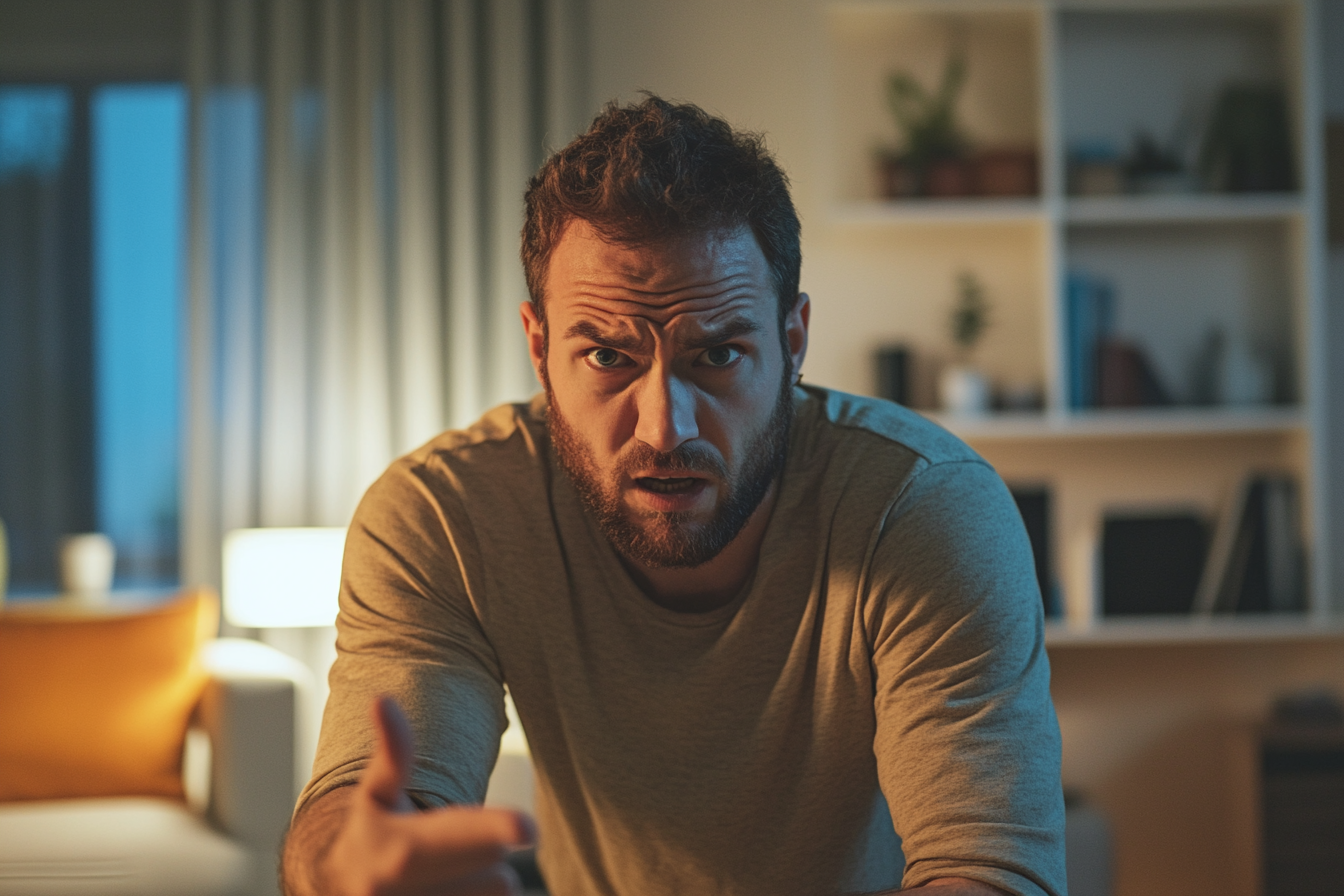
A man speaking angrily to someone | Source: Midjourney
A banner, not yet hung, with golden letters that read “Happy 10th Anniversary!” The metallic paper caught the light from our living room lamps, throwing sparkles across the ceiling.
The room went completely silent. Laura’s hands covered her mouth, tears welled in her eyes, and she smudged her carefully applied makeup. Mr. Smiles cleared his throat and stepped forward, his famous grin nowhere to be seen.
“Sir, I think there’s been a misunderstanding,” he said softly, his professional demeanor never wavering. “I’m a wedding planner and party animator. Your wife hired me months ago to plan this event — your wedding anniversary!”
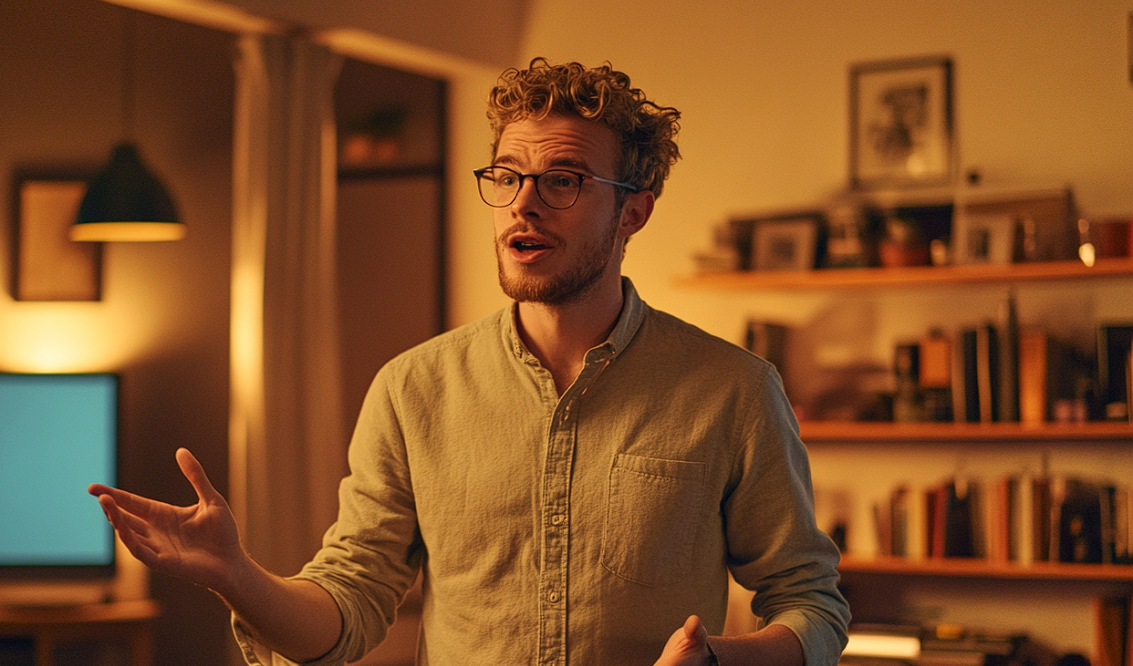
A man speaking in a living room | Source: Midjourney
“You thought I was cheating on you?” Laura’s voice cracked with hurt and disbelief, each word falling like a stone between us.
I felt the floor shift beneath my feet. The room suddenly seemed too bright, too crowded, the decorations garish and mocking.
“I… I didn’t know what else to think,” I stammered, my collar feeling too tight. “I saw him coming here, and Oliver said a man kept visiting while I was at work, that this man made you laugh…”

An emotional man looking confused and shocked | Source: Midjourney
“Oliver said he made me laugh because he does magic tricks for him when we plan,” Laura interrupted, her voice rising. “I was trying to do something special for you, and you thought I was unfaithful?”
My throat felt tight. “I’m sorry,” I managed to say, the words feeling inadequate. “I was wrong. I let my insecurities get the better of me.”
Laura wiped her eyes with the back of her hand, leaving a dark smudge of mascara. “How could you think that? After everything we’ve been through?”

An emotional woman speaking to her husband | Source: Midjourney
The party guests began quietly filing out, murmuring awkward goodbyes, their shoes shuffling across our carpet.
My sister squeezed my shoulder as she left, whispering, “Fix this.” Oliver looked confused and scared, so Laura’s mother took him upstairs to his room, their footsteps echoing in the tense silence.
When we were finally alone, Laura sat on the couch, her shoulders slumped. The streamers lay in tangles around her feet.

An upset woman sitting on a sofa | Source: Midjourney
“I spent months planning this,” she said quietly. “I wanted it to be perfect. Remember our first anniversary? When you surprised me with that picnic in the park? I wanted to do something just as special.”
I sat beside her, careful to leave space between us, the cushions dipping under my weight. “I ruined everything.”
“Yes, you did.” She turned to look at me, her eyes red but fierce. “Trust isn’t just about believing in someone when everything’s perfect. It’s about believing in them when things don’t make sense.”
“I know,” I whispered, feeling the weight of my mistake. “I forgot that somewhere along the way. Can you forgive me?”

A couple having a serious conversation | Source: Midjourney
Laura was quiet for a long moment, her fingers tracing patterns on the fabric of her dress.
“I love you,” she said finally. “But this isn’t something I can just get over. You need to understand how much this hurts.”
I nodded, feeling tears start to fall. “I’ll do whatever it takes to make this right.”
“It won’t happen overnight,” she warned, her voice stern but not unkind.

A stern-looking woman speaking to someone | Source: Midjourney
“I know. But I’m not going anywhere.” I reached for her hand, and after a moment’s hesitation, she let me take it, her fingers cool against my palm. “Happy anniversary,” I said softly.
She gave a watery laugh that held both forgiveness and reproach. “Happy anniversary, you idiot.”
Upstairs, we heard Oliver laughing at something, probably one of his grandmother’s stories. The sound filled our living room, reminding us of all we had to lose, and all we had to save.

A couple in a living room glancing upwards | Source: Midjourney
This work is inspired by real events and people, but it has been fictionalized for creative purposes. Names, characters, and details have been changed to protect privacy and enhance the narrative. Any resemblance to actual persons, living or dead, or actual events is purely coincidental and not intended by the author.
The author and publisher make no claims to the accuracy of events or the portrayal of characters and are not liable for any misinterpretation. This story is provided “as is,” and any opinions expressed are those of the characters and do not reflect the views of the author or publisher.



Leave a Reply